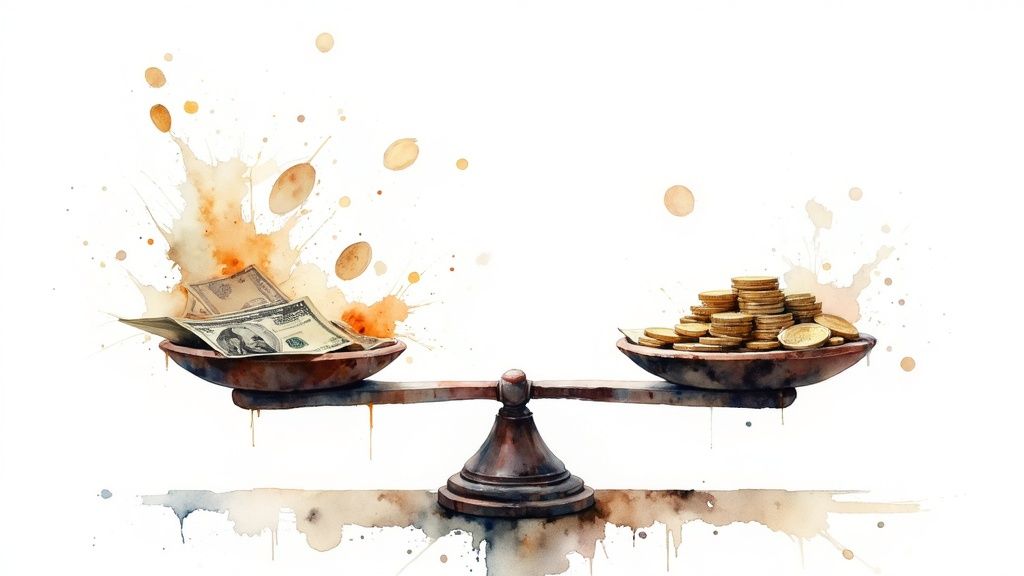




Money debasement - the intentional reduction of a currency's value - has shaped economies throughout history. From ancient empires to modern nations, governments have repeatedly manipulated their money supply with far-reaching effects on society. Examining these historical patterns offers crucial lessons about monetary policy and its impact on economic stability.
The Roman Empire provides one of history's clearest examples of currency debasement. When Rome's silver denarius first entered circulation, it contained nearly pure silver. However, as military campaigns and public spending strained the treasury, emperors began adulterating the coins with cheaper metals. Emperor Nero started this practice around 60 AD by reducing the silver content to 90%. The debasement accelerated over time - by 265 AD, the denarius contained a mere 0.5% silver. The consequences were severe: skyrocketing prices, loss of public confidence, and economic instability that contributed to Rome's eventual collapse.
Several centuries later, England experienced its own monetary crisis under Henry VIII. Struggling with massive debts, the king launched what became known as The Great Debasement. He systematically reduced the precious metal content of English coins, with gold purity falling from 23 to 20 karats. The silver content saw an even more dramatic decline, plunging from 92.5% to just 25%. As prices rose sharply and economic hardship spread, England learned firsthand how currency manipulation can trigger a destructive cycle of inflation and instability.
Perhaps no episode better illustrates the dangers of currency debasement than Germany's hyperinflation after World War I. Faced with crushing war reparations and economic crisis, the Weimar Republic resorted to printing money on an unprecedented scale. The result was a complete collapse in the German mark's value - at one point, it took billions of marks to buy a single US dollar. The social and economic trauma of this period left deep scars on German society and serves as a stark warning about the risks of reckless monetary expansion.
Money debasement, whether through diluting precious metals or excessive printing, has consistently produced economic pain throughout history. These examples highlight why understanding currency stability is crucial for both policymakers and citizens. The historical record makes clear that protecting a currency's integrity is essential for sustainable economic growth and social stability.

The decline and fall of the Roman Empire provides a striking case study in monetary mismanagement. While the empire's early strength rested partly on its stable currency - the silver denarius - this same monetary system eventually contributed to Rome's downfall through systematic debasement. The denarius initially served as a trusted store of value that enabled trade and commerce throughout the empire's vast territories.
The debasement of Roman currency began subtly but grew increasingly severe over time. In 60 AD, Emperor Nero took the fateful step of reducing the denarius's silver content to 90% - a modest change that established a dangerous pattern. As military costs and public spending mounted, subsequent emperors further diluted the silver content to stretch their budgets. By 120 AD, the denarius contained only 50% silver, meaning citizens who had saved these coins saw their wealth cut in half. Like termites slowly hollowing out a wooden beam, this steady erosion of value eventually led to the currency's collapse.
The effects of debasement rippled through Roman society with devastating impact. As the denarius lost value, prices for everyday goods skyrocketed - a loaf of bread that cost one coin might suddenly require ten. This rampant inflation hit ordinary citizens hardest, from merchants watching their profits vanish to soldiers whose wages bought less each year. The economic instability fueled social unrest as people struggled to afford basic necessities. Trust in the government eroded along with the currency.
By 265 AD, the debasement reached its endpoint - the once-proud silver denarius now contained a mere 0.5% silver, becoming essentially a bronze token. This final degradation rendered the currency practically worthless, like a car without an engine. The results were catastrophic: hyperinflation paralyzed commerce, savings were wiped out, and the social fabric of the empire began to unravel under immense strain. This cautionary tale from antiquity demonstrates how debasing a currency can destabilize even history's mightiest empires. The denarius's demise reinforces a timeless principle: maintaining sound money is essential for economic and social stability.
Henry VIII's name echoes through history as much for his economic missteps as for his dynastic turmoil. While his marriages and religious reforms draw the most attention, his financial policies inflicted severe damage on England's economy. The Great Debasement stands out as a particularly ruinous attempt to solve the crown's money troubles. Faced with mounting costs from wars with France and Scotland, along with his own extravagant spending, Henry VIII chose to systematically reduce the precious metal content in English coins - a decision that would have far-reaching consequences.
The process of debasement involved carefully calculated changes to coin composition. Gold coins saw their purity drop from 23 karats to 20 karats. The silver coinage suffered an even more dramatic decline - the sterling silver content plunged from 92.5% to just 25%, with copper making up the difference. While the coins maintained their outward appearance, their actual value had been severely diminished. The process mirrored watering down a fine wine - the quantity increased but the quality was compromised.
The effects of Henry VIII's monetary manipulation spread through the economy like ripples in a pond. The most immediate impact was rapid inflation as prices rose sharply across the board. With debased coins containing less precious metal, more were needed to purchase the same goods and services. This hit common people especially hard since their wages failed to keep pace with rising costs. For many families, basic necessities that were once affordable became increasingly out of reach as their money lost its purchasing power.
When Edward VI inherited the throne from his father, he recognized the urgent need to address the currency crisis. In 1551, he took the decisive step of restoring silver coins to their original 92.5% purity standard. However, the economic damage could not be quickly undone. It took until 1560 for all of the debased coinage to be removed from circulation, marking the end of this tumultuous period. The long path to recovery highlighted how deeply currency manipulation could destabilize an entire economy.
The Great Debasement serves as a cautionary tale about the risks of manipulating currency for short-term gain. While modern governments no longer dilute precious metals in coins, they can achieve similar effects through excessive money creation that outpaces economic growth. This can trigger inflation and erode purchasing power just as surely as Henry VIII's debasement did. The episode demonstrates that maintaining sound money is essential for economic stability - a lesson that remains highly relevant for monetary policy today. Understanding this historical case helps illuminate the long-term consequences that can flow from efforts to solve immediate financial problems through currency manipulation.

Beyond officially sanctioned debasement through metal content changes, a secretive world of unauthorized coin manipulation persisted for centuries through clipping and counterfeiting. These illegal activities created ongoing instability in economies and pushed authorities to develop new security measures. Examining these historic monetary crimes reveals striking parallels to modern financial security challenges.
Coin clipping was the practice of shaving tiny amounts of precious metal from coin edges. While each individual act seemed minor, the cumulative effect across an economy could significantly reduce the money supply's value. In 17th century England, clipping became so widespread that it seriously degraded the currency. Much like how small cracks in a foundation can eventually compromise an entire building, the systematic removal of metal from coins gradually undermined the monetary system's stability.
Counterfeiting posed an even more direct threat by introducing completely fake coins into circulation. Unlike clipping which diminished real currency, counterfeiting flooded markets with worthless imitations. This created a dual problem - not only did fake coins lack actual value, but their existence made people suspicious of all coins, even legitimate ones. The resulting loss of public confidence often triggered wider economic problems, similar to how bank runs can spiral from initial doubts about an institution's stability.
Governments fought back against these threats through multiple approaches. Officials imposed harsh penalties, including death sentences in England for coin clippers, showing how seriously they viewed these crimes. They also developed improved coin designs and minting methods to prevent tampering. For example, the Great Recoinage of 1696 in England, overseen by Sir Isaac Newton, introduced milled edges on coins - a security feature still used today. These efforts demonstrated an early understanding of how protective design could deter criminal activity.
The historic battle against coin manipulation offers relevant insights for protecting modern financial systems, especially cryptocurrencies. Today's challenges with securing digital assets mirror past struggles against physical coin fraud. Just as milled edges made clipping more difficult, modern cryptographic protocols aim to prevent unauthorized manipulation of digital currencies. The core principle remains constant across centuries - effective security measures must evolve alongside new threats. For example, blockchain technology provides an immutable transaction record that serves a similar anti-tampering function as physical coin security features did historically. This shows how the fundamental need to maintain monetary integrity continues, even as the specific methods adapt to new forms of currency.
The collapse of a currency system can devastate an entire society, as dramatically illustrated by the hyperinflation that engulfed Germany's Weimar Republic after World War I. This historical case offers a stark example of how quickly monetary problems can spiral out of control, impacting every aspect of daily life. The Weimar experience provides essential lessons about the human cost of currency debasement and the desperate measures people take to survive economic chaos.
The roots of Germany's monetary disaster trace back to the Treaty of Versailles and its punishing war reparations demands. To meet these obligations, German officials turned to what seemed like a straightforward solution - printing more money. While this provided temporary relief, it set off a dangerous chain reaction. As the money supply expanded, the mark's value fell sharply. This forced the government to print even larger quantities of currency to cover expenses, creating an accelerating cycle of debasement and soaring prices.
The human reality of hyperinflation was brutal and surreal. Prices changed not just daily but hourly, with a simple loaf of bread eventually costing billions of marks. People rushed to spend their wages immediately before the money lost more value. Many workers insisted on being paid multiple times per day just to buy basic necessities before prices climbed higher. Life savings vanished almost overnight, pushing countless families into poverty. The intense economic pressure frayed social bonds and community ties.
As the currency crisis deepened, Germans developed creative ways to preserve their purchasing power. Many turned to direct bartering of goods and services to avoid using worthless paper money. Some protected wealth by investing in hard assets like real estate, artwork and even postage stamps. Foreign currencies, especially US dollars, became prized as stable stores of value. These adaptive strategies highlight key principles about protecting assets during monetary instability - principles that remain relevant for investors today.
The Weimar hyperinflation emerged gradually through clear warning signals, including rapid money supply growth, rising government debt, and declining currency value. While Germany's post-war circumstances were unique, similar red flags can appear in modern economies. For instance, substantial government spending funded by monetary expansion can generate inflationary forces that erode purchasing power over time. By studying these historical patterns, we can better spot developing risks and take steps to shield ourselves from currency debasement. The Weimar Republic's catastrophic experience serves as an enduring reminder of the importance of sound money and fiscal discipline.

History offers clear lessons about currency debasement, from ancient Rome to the Weimar Republic: protecting wealth requires active defense strategies. While methods have evolved from clipping coins to manipulating interest rates, the core principle persists - when money supply increases excessively, its value falls. This raises an important question: what specific steps can we take to protect our finances in today's environment?
Just as Romans who spread their holdings across land and goods survived the denarius's decline better than others, modern investors benefit from broad asset diversification. Beyond standard stocks and bonds, consider:
Today's investors have access to additional protective tools:
Government debt directly affects currency stability. Henry VIII's Great Debasement showed how high debt can tempt governments to inflate their way out of fiscal problems. This makes monitoring national debt levels essential - when government debt grows much faster than economic output, currency debasement often follows.
Financial conditions change constantly. Success requires staying current on economic trends, policy decisions, and world events that affect markets. This knowledge helps you adjust your approach as needed. Just as governments had to develop new anti-counterfeiting measures like milled coin edges, investors must continue refining their wealth preservation strategies as circumstances evolve.
Ready to take control of your crypto investments and stay ahead of the curve? Coindive provides the tools and insights you need to navigate the dynamic cryptocurrency market. Visit Coindive today and experience the future of crypto tracking.